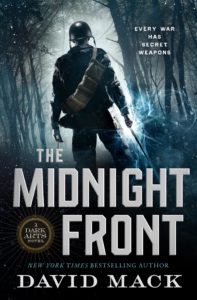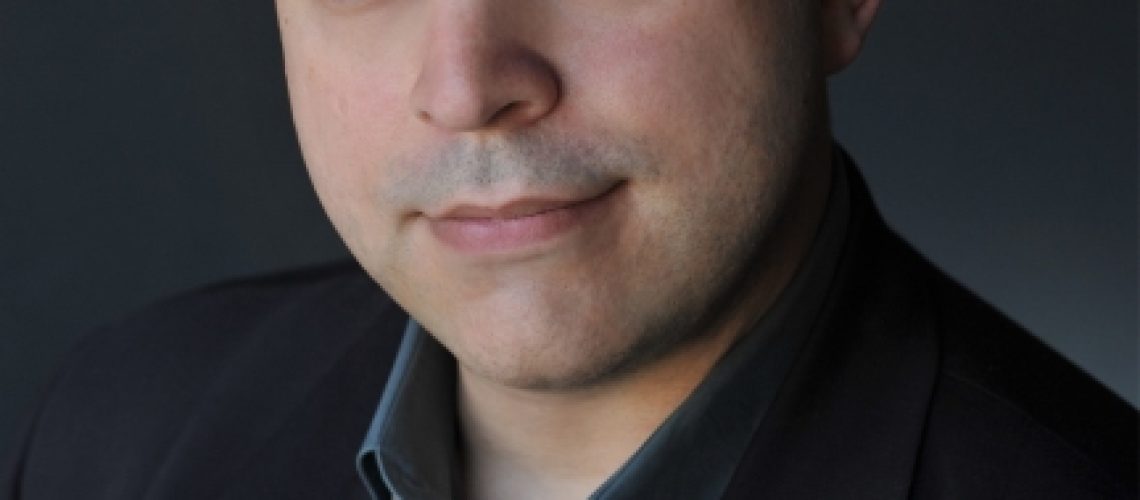Today on Skiffy and Fanty, I interview the author of Midnight Front and The Iron Codex (among very many other things), David Mack.
PW: You’ve penned sequels and follow-on novels in the various fictional universes you’ve written in before. What was different about your process in tackling The Iron Codex?
DM: Adding stories to the ongoing literary continuity of Star Trek, as I’ve been doing since 2001, is very different from writing a sequel to my own original novel.
When I write a Star Trek novel, I’m able to take advantage of the fact that many ideas and concepts don’t need to be explained in great detail, because readers of Star Trek novels are already familiar with the series’ setting and characters.
When I started plotting The Iron Codex, I had to deal with challenges that were new to me. One was that I needed to quickly refresh readers’ understanding of the complicated system of ceremonial magic I had developed in the first Dark Arts novel, The Midnight Front. But I also wanted the plot of book two to move quickly, in the style of classic Ian Fleming spy-thrillers.
Another issue that made The Iron Codex a new experience for me was the open-ended nature of the research it required. For The Midnight Front, my WWII setting had been extensively documented and time-lined. But I embarked upon book two with only a vague sense of when it would take place, and the locations came later. Consequently, finding reliable information about disparate places and topics specific to early 1954 proved to be a research challenge.
I compiled a spreadsheet of historical events from early 1953 through early 1955, and then I split them into columns based on geography. Next, I built a second spreadsheet, with one character per column, and then I worked to match their story arcs to real events from history.
Much of what I put into those spreadsheets ended up discarded, but that was how I zeroed in on the elements that came to define the historical boundaries of The Iron Codex.

PW: The Midnight Front is a WWII novel. The Iron Codex jumps into the 1950s. Why the time jump to the events of the second novel?
DM: That was always the plan for the Dark Arts series: for each book to take place in a different era of 20th-century geopolitical history, and to have a unique style or tone. From the outset, book one was meant to be a war epic and an origin story. Book two was meant to be a fast-paced spy thriller. Book three, The Shadow Commission, was plotted and written as a paranoid conspiracy piece set in the week after the assassination of President John F. Kennedy.
My reasons for this shift of setting and style with each book was twofold. First, I didn’t want to keep writing the same kind of book, over and over. The idea of jumping from war to war didn’t interest me. Besides, after writing a World War II epic, how is one supposed to top that? Second, I felt that readers might also enjoy the variety of a series built upon a core cast and a consistent magic system, but with the freedom to explore different settings and genres.
This also lent itself to another fun feature that I noted only after I had started working on book three, which is that the time frame of each book is tighter than the last one. The Midnight Front transpired over a period of six years; The Iron Codex takes place over roughly sixty days; The Shadow Commission unfolds over seven days. My idea for a fourth book—a heist thriller—would happen all in a single night.
PW: The Cold War is full of “Can you believe this?!” events. What real-life events did you want to make sure you could background or echo in plot while writing a novel set during the period?
DM: There were many real-life events I had hoped to work into The Iron Codex, but in the end I pared them down to just the few that served the larger story I wanted to tell. Before I drafted the outline, I’d thought that the Red Scare and the investigations of Senator Joseph McCarthy were going to feature more prominently than they did. Ultimately, I scaled back that element in order to establish another that I needed in place for book three, The Shadow Commission.
However, just as I seeded real historical events into The Midnight Front, I did so with The Iron Codex. For example, early in the novel we see the machinations that lead to the crash of a commercial airliner, BOAC Flight 781 out of Rome. With the exception of the involvement of a demon, the details of that airline disaster are all completely factual.
Other historical elements woven into The Iron Codex include the truth about how the Roman Catholic Church helped fugitive Nazi officers escape Europe and start new lives under aliases in such South American countries as Argentina, Brazil, Uruguay, Paraguay, and Bolivia.
Sharp-eyed readers might also catch allusions to the infamous 1947 UFO incident at Roswell, N.M.; a milestone moment in the career of jazz legend Miles Davis; the role of a practicing member of Thelema in the U.S. space program; and, of course, the detonation of the highest-yield hydrogen bomb ever triggered by the United States, on Bikini Atoll in the Marshall Islands.

PW: You’ve written for television; what television or movies were inspirational in bringing the world of The Iron Codex to your mind and page?
DM: Some of the most important inspirations, clearly, were the James Bond films I grew up watching in my youth. In particular, films such as From Russia With Love, For Your Eyes Only, The Living Daylights, and the 2006 remake of Casino Royale.
My real creative driver when I write, however, is music. In addition to the film scores for the movies mentioned above, I drew significant inspiration for The Iron Codex from the film scores for Kingsman: The Secret Service, X-Men: First Class, Quantum of Solace, and Skyfall. (Those who want to know more about this should check out my Guide to my Iron Codex Spotify Playlist.)
PW: Espionage and SF/F are like peanut butter and chocolate in how they can harmonize despite being separate genres. What do you think each genre can learn from the other?
DM: I’m not sure that either genre has to “learn” anything from the other. Each of them is fairly broad to begin with. I think that helps make each of them more malleable. Spy thrillers can be paranoia pieces such as Enemy of the State or Three Days of the Condor, or they can be more action-driven, such as the James Bond films, or even blended with a healthy dose of comedy, such as in the Kingsman films. Because the espionage subgenre also tends to have a strong techno-thriller component, it tends to mesh well with technology-driven science-fiction ideas, or, in the case of The Iron Codex, with fantastical magic systems that are detailed enough to appear scientific.
PW: With The Iron Codex out, what’s next for you?
DM: My next scheduled publication is book three of the Dark Arts series, The Shadow Commission. Slated for release on June 9, 2020, by Tor Books, it’s a paranoid conspiracy thriller set in late 1963, during the week after the assassination of President John F. Kennedy. Think of it as John Constantine meets Three Days of the Condor.
After that—or maybe before it, depending on the whims of the publisher—I will have a new Star Trek: The Next Generation novel on shelves sometime in the next year or so. Its current title is Collateral Damage, and I’m roughly halfway through writing the manuscript at this time.
PW: Where can readers and fans find you, at conventions and the like this year? Where can they find you online?
DM: I have three convention appearances scheduled for the rest of 2019.
The first one up is Shore Leave Convention, in Hunt Valley, Md., July 12–14.
Next, I’ll be on panels and other programming at the Gen Con Writers’ Symposium in Indianapolis, August 1–4.
After that, I’ll be the second keynote speaker at the C3: Creatures, Crime & Creativity conference in Columbia, Md., September 13–15.
I might make an appearance at New York Comic-Con in October, and I’m on the fence about attending World Fantasy Convention in Los Angeles in November.
As for where to find me online, my official website is davidmack.pro and my Twitter handle is @DavidAlanMack.
PW: Thanks, David!








One Response